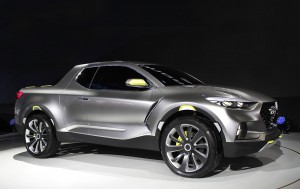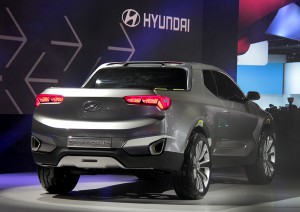
Hyundai said show-goers gave a thumbs up to the Santa Cruz concept, which will be the basis of a midsize truck.
Hyundai has long struggled to find a way to get into the pickup truck segment without much success. The Korean automaker, and its sibling, Kia Motors, is actively trying to develop a midsize truck with a design that differentiates it from the competition, and drives buyers to showrooms.
The Korean siblings are moving slowly. Any truck they introduce will undergo substantive scrutiny due to the highly competitive nature of the segment. The midsize arena has only grown tougher in the last year as General Motors introduced its new Chevrolet Colorado and GMC Canyon and Toyota is set to launch its redesigned Tacoma.
The midsize segment is filled with also-rans, such as the Honda Ridgeline, that missed the mark initially and haven’t regained their footing. For that reason, Hyundai, and Kia, are exercising caution, but the Santa Cruz garnered a strong response so it is being considered as the basis for a pickup truck, an executive told reporters.
However, Park Byung-cheol, a director at Hyundai’s R&D division, according to wire service reports from South Korea. The concept truck shown in Detroit got a “good response,” meaning it was generally successful in attracting the interest of potential customers who have seen the vehicle up close or viewed the truck from media reports.
Last week, reports from South Korea indicated that Hyundai Motor Co has decided to move ahead with construction of a new assembly plant in the United States. The new plant, Hyundai’s second in the United States, would be located near Montgomery, Alabama, not far from Hyundai’s existing U.S. assembly plant, according to South Korea’s Yonhap News Agency, which cited unnamed sources.
Hyundai officials declined to confirm the report for various news agency. But it has been no secret that Hyundai executives in North America have been pressing the company’s headquarters for a new plant, arguing it would create new opportunities in the U.S. market where sales have been hurt by product shortages.
(Hyundai Santa Cruz concept asks: when is a truck not a truck. For more, Click Here.)
The new plant in Alabama would have an annual production capacity of 300,000 vehicles, Yonhap reported, noting it would break ground this year and start SUV production in 2017.
A second plant also would insulate the North American market from the periodic labor unrest in South Korea and bottlenecks at U.S. ports. While the timing for the next plant hasn’t been disclosed, it could help the South Korean automaker ease into the lucrative U.S. truck market.
(Click Here for details about a second Hyundai plant in the U.S.)
Japanese brands, such as Toyota, Nissan and Honda, have tried to penetrate the U.S. truck market with varying but limited degrees of success but Hyundai has eyed the market for the better parts of two decades and could finally be on the verge of a commitment.
Hyundai currently depends on passenger car sales, which have slowed as U.S. consumers are shifting to trucks and sport utility vehicles. Light-duty trucks are expected to account for a larger percentage of sales in the U.S. over the next few years, according to projections prepared by rivals such as Ford Motor Co.
(To see more about the new Hyundai Tucson, Click Here.)
Hyundai builds its Elantra compact and Sonata midsized sedan at its U.S. factory in Alabama and the Santa Fe SUV at a factory in Georgia operated by Kia, an affiliate and partner of Hyundai Motor.
Kia Motor also plans to start production at its first plant in Mexico the first half of 2016, to help ease capacity constraints at its U.S. factory.


I’d like to know how many customer checks they actually have to show “serious interest”. I find it really hard to believe anything looking like this concept vehicle will sell in even remotely reasonable volume to even come close to breakeven.